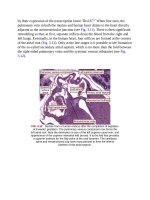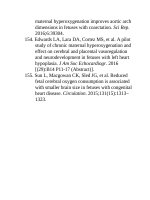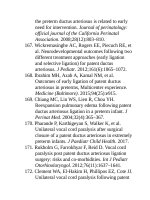Andersons pediatric cardiology 1069
Bạn đang xem bản rút gọn của tài liệu. Xem và tải ngay bản đầy đủ của tài liệu tại đây (99.12 KB, 3 trang )
OutcomesAfterSurgery
Historically,surgicalrepairofcommonarterialtrunkhasbeenassociatedwith
highmortality.ThusthePediatricCardiacCareConsortiumreportedamortality
rateof44%forpatientswhounderwentsurgerybetween1985and1993.54
Althoughshort-termoutcomeshavesinceimproved,morerecentauditscontinue
toreportsignificantmortalityinthisgroupofpatients.Arecentupdatefromthe
SocietyofThoracicSurgeonsreportedanoperativemortalityof9.4%.55Brown
andcoworkersreportedanearlymortalityrateof17%forpatientsundergoing
surgerybetweentheyears1978and2000.Themedianageatthetimeofsurgery
was76days.Thisreporthighlightedthecontributionofassociatedcardiac
anomalies,suchasinterruptionoftheaorticarch,orstenosisofthetruncalvalve,
toperioperativemortality.Theseanomalieswereassociatedwithaperioperative
mortalityof29%,comparedwith9%forpatientswithoutthesecomplicating
factors.56Patientswiththe22q11deletionsyndromehavebeenshowntorequire
amoreprolongedstayintheintensivecareunitandinthehospitalaftersurgery,
aswellasmorereinterventionsintheearlypostoperativeperiod.57Arecent
retrospectivereviewofpatientswhounderwentsurgeryinMelbourne,Australia,
between1979and2014,demonstratedanearlymortalityrateof11.7%.The
requirementforpostoperativeextracorporealmembraneoxygenation,theweight
ofthepatients,priorsurgicalintervention,andananomalyofacoronaryartery
wereidentifiedasriskfactorsforearlymortality.58Inthisseries,interruptionof
theaorticarchortherequirementforrepairofthetruncalvalvewasnotarisk
factorforearlymortality.Earlytranscatheterorsurgicalreinterventiontothe
pulmonaryarteriesorrightventricularoutflowtractwillberequiredinupto
one-in-threepatientswithinthefirstyearaftersurgery.Inaseriesofpatients
whounderwentsurgeryinBoston,theuseofasmallerconduitwasan
independentriskfactor.59
Inthemediumterm,thefunctionaldevelopmentaloutcomeissatisfactoryfor
mostpatients.60However,afterrepair,manypatientsdemonstrateongoingand
significantcomorbidities,commonlyrequiringsurgicalandcatheter-based
interventions,withabnormalitiesinexerciseperformance,functionalstatus,and
health-relatedqualityoflife.61Themainprobleminthemediumtermisrelated
totheconduitplacedbetweentherightventricleandpulmonaryarteries.Ina
recentseriesfromBoston,inwhichthemajorityofpatientsreceiveda
homograftconduit,thefreedomfromeitherreinterventionorsurgeryat14years
wasonly4%.62Althoughreplacementoftheconduitbetweentherightventricle
andthepulmonaryarterieshasbecomethedefinitivemethodtorelieve
obstruction,transcatheterangioplastyhasbeenreportedinanumberofseries,
withvariableoutcomes(Fig.40.21).However,thereareanumberofreportsthat
suggestthatpercutaneousimplantationofstentsmayresultinsignificant
immediatehemodynamicimprovementand,insomepatients,mayprolongthe
lifespanoftheconduitbyseveralyears.Transcatheterreplacementofthe
pulmonaryvalve,usingessentiallyavalvedstent,islikelytorevolutionizethe
careofthesepatients.InanearlymulticenterstudyoftheMelodyvalve,of404
patientsenrolledinthestudy,46hadundergonerepairofcommonarterial
trunk.63Forsmallerpatients,aperiventricularapproachmaybeused.64As
newervalvesaredeveloped,theopportunitiesforpercutaneousapproachesin
smallerpatientswillbeexpanded.
FIG.40.21 Transcatheterdilationofconduitstenosis.(A)Right
ventriculogramdemonstratesasignificantstenosisoftheconduit.(B)
Inflationoftheballoonrevealedawaistatthesiteofthestenosiswas
relievedbyfurtherinflation.(C)Attheendoftheprocedure,arepeat
ventriculogramdemonstratedpartialreliefofthestenosis.
Withimprovementsinperioperativesurvival,thereisincreasinginformation
emergingaboutoutcomesinthelongerterm.IntheMelbourneseriesofpatients
operatedonbetween1979and2014,theoverallsurvivalratewas73.6%at30
years.58ThepresenceofDiGeorgesyndromewasariskfactorforlatemortality.
Freedomfromreoperationtotherightventricularoutflowtractwas4.6%at20
years.Inthisseries,therequirementforrepairofaninterruptedaorticarchorof
thetruncalvalvewerenotriskfactorsforlatermortality.Inasmallerseriesof
patientswhounderwentsurgeryinTokyobetween1974and2002,actuarial
survivalwas97%at10yearsand93%at40years.65However,freedomfrom
reoperationtothepulmonaryoutflowtractwasonly3%andfromreplacement
ofthetruncalvalvewas70%at20yearsaftertheinitialsurgery.









